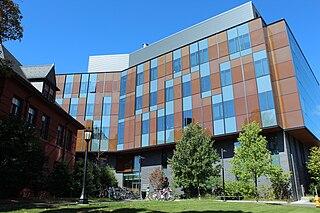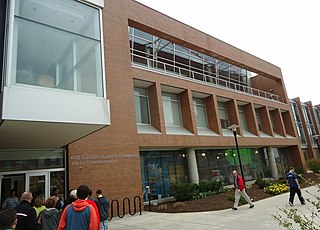
The University of California, Berkeley College of Engineering is the engineering school of the University of California, Berkeley, a public research university in Berkeley, California.

The Pratt School of Engineering is located at Duke University in the United States. The school's associated research, education, alumni and service-to-society efforts are collectively known as Duke Engineering.

The School of Engineering is one of the ten schools that comprise Tufts University. The school offers undergraduate and graduate degrees in several engineering disciplines and computer science fields. Along with the School of Arts and Sciences (A&S) and the Fletcher School of Law and Diplomacy, the School of Engineering is located on the university's main campus in Medford and Somerville, Massachusetts. Currently, the engineering school enrolls more than 800 full-time undergraduates and 600 graduate students. The school employs over 100 full-time and part-time faculty members.

The Cal Poly San Luis Obispo College of Engineering is the engineering college of the California Polytechnic State University, San Luis Obispo in San Luis Obispo, California. It has nearly 250 faculty members and more than 6,000 students enrolled in fourteen bachelor's and in eleven master's degree programs through nine engineering departments. Its facilities house more than 80 classrooms, laboratories and work spaces occupying more than 160,000 square feet. In the 2021 U.S. News & World Report's "America's Best Colleges" edition, the College of Engineering is ranked 8th out of 220 public and private undergraduate engineering schools in the U.S. where doctorates are not offered.
Santa Clara University School of Engineering was founded and began offering bachelor's degrees in 1912. Over the next century, as the Santa Clara Valley transformed from a largely agricultural area to an industrial center, the school added master and doctoral programs designed to meet the area's growing need for expert engineers. Today, the Silicon Valley provides a setting for the school's programs offered through a broad range of departments.

The UTSA Klesse College of Engineering and Integrated Design (CEID) houses The University of Texas at San Antonio's Engineering and Architectural, Construction and Planning programs. It was originally founded as the College of Engineering but was renamed to the Klesse College of Engineering and Integrated Design (CEID) in 2021.

The McMaster Faculty of Engineering is a faculty located at McMaster University in Hamilton, Ontario. The faculty was established in 1958 and was the first engineering program to developed problem-based learning curriculum. It currently has seven departments in chemical engineering, civil engineering, computing and software, electrical and computer engineering, engineering physics, material science and engineering and mechanical engineering. The faculty offers bachelors, masters, and doctoral degrees.
The School of Engineering and Applied Science (SEAS) at the George Washington University in Washington, D.C. is a technical school which specializes in engineering, technology, communications, and transportation. The school is located on the main campus of the George Washington University and offers both undergraduate and graduate programs.

The Gokongwei College of Engineering of De La Salle University is one of eight colleges that comprise the University. It was established in 1947 with the aim of providing young men who are knowledgeable in science and technology to help rehabilitate the Philippines, which was then devastated in the aftermath of World War II.

The Kate Gleason College of Engineering (KGCOE) is the engineering college at the Rochester Institute of Technology. The college is home to all of RIT's engineering programs except for software engineering, which is part of the B. Thomas Golisano College of Computing and Information Sciences. Entering the 2023-24 academic year, the student body consisted of 2,947 students, with 400 graduate students. About 23% of the students were female.

The University of Pennsylvania School of Engineering and Applied Science is the undergraduate and graduate engineering school of the University of Pennsylvania, a private research university in Philadelphia. The school offers programs that emphasize hands-on study of engineering fundamentals while encouraging students to leverage the educational offerings of the broader University. Engineering students can also take advantage of research opportunities through interactions with Penn’s School of Medicine, School of Arts and Sciences, and the Wharton School.

The Purdue University College of Engineering is the engineering school and one of eight major academic divisions of Purdue University, a public research university in West Lafayette, Indiana. Established in 2004, its forerunner began in 1874 with programs in Civil and Mechanical Engineering.
The College of Engineering and Applied Science is the engineering and applied science college of the University of Cincinnati in Cincinnati, Ohio. It is the birthplace of the cooperative education (co-op) program and still holds the largest public mandatory cooperative education program at a public university in the United States. Today, it has a student population of around 4,898 undergraduate and 1,305 graduate students and is recognized annually as one of the top 100 engineering colleges in the US, ranking 83rd in 2020.
The School of Engineering at Rutgers University was founded in 1914 as the College of Engineering. It was originally a part of the Rutgers Scientific School, which was founded in 1864. The school has seven academic departments, with a combined undergraduate student enrollment of over 2,400 students. It offers over 25 academic and professional degree programs. These include several interdisciplinary programs, such as Environmental Engineering with the Department of Environmental Science, and the graduate program in mechanics.
The College of Engineering at Michigan State University (MSU) is made up of 9 departments with 168 faculty members, over 6,000 undergraduate students, 10 undergraduate B.S. degree programs and a wide spectrum of graduate programs in both M.S. and Ph.D. levels. Each department offers at least one degree program, however many include more than one degree, multi-disciplinary programs, certifications and specialties as well as other degree programs affiliated with other colleges at Michigan State University.

The Henry Samueli School of Engineering (HSSoE) is the academic unit of the University of California, Irvine that oversees academic research and teaching in disciplines of the field of engineering. Established when the campus opened in 1965, the school consists of five departments, each of which is involved in academic research in its specific field, as well as several interdisciplinary fields. The school confers Bachelor of Science, Master of Science, and Doctor of Philosophy degrees.

The John and Marcia Price College of Engineering at the University of Utah is an academic college of the University of Utah in Salt Lake City, Utah. The college offers undergraduate and graduate degrees in engineering and computer science.

The Virginia Commonwealth University College of Engineering is a Richmond-based engineering education institution that offers undergraduate and graduate degrees in biomedical engineering, chemical and life science engineering, computer science, electrical and computer engineering, and mechanical and nuclear engineering. Established as the "School of Engineering" in 1996, its name and status was officially changed to the College of Engineering in April 2018. The college's dean, Barbara D. Boyan, cited doubled faculty numbers and an increase in funding as reasoning for the switch from school to college.

The Fred DeMatteis School of Engineering and Applied Science (SEAS) is the engineering school of Hofstra University, a private university in Hempstead, New York. It was created in 2012 out of the previously existing Departments of Engineering and Computer Science. It is accredited by ABET.

The School of Engineering, Trinity College Dublin is the oldest engineering school in Ireland and one of the oldest in the world. It provides undergraduate, taught postgraduate and research degrees in engineering. It is the highest-ranked engineering school in Ireland by QS Rankings and by Times World University Rankings.















